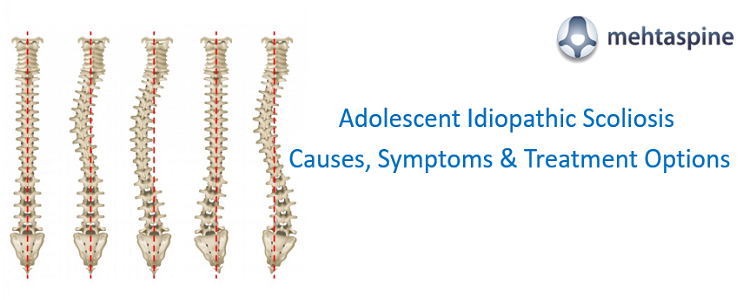Adolescent Idiopathic Scoliosis – Causes, Symptoms & Treatment Options
Scoliosis is a spine disorder that is characterized by the abnormal lateral curve of the human spine. The spine of the patient affected by the Scoliosis is curved sideways and in severe cases even undergoes a rotation too. Scoliosis can affect any part of the spine but the most common regions happen to be the middle and lower back.
And several types of Scoliosis affect both children and adolescents and the most common form is the Scoliosis for which the exact causes are unknown, called Idiopathic Scoliosis. Approximately 85% of the Scoliosis cases are Idiopathic and this Idiopathic Scoliosis can be further classified into three types based on the age of onset:
- Infantile Idiopathic Scoliosis (Birth to 2 years)
- Juvenile Idiopathic Scoliosis (3 to 9 years)
- Adolescent Idiopathic Scoliosis (10- 18 years)
Adolescent Idiopathic Scoliosis:
Adolescent Idiopathic Scoliosis is the most common type of Scoliosis suffered by children between the ages of 10 and 18. As the onset of the curve coincides with the growth spurt of the children, the possibility of curve progression increases, severely impacting the body anatomy over time.
In most cases, the curve is mild, painless, stays stable and does not cause breathing or movement problems. However, in a few cases, the curve progresses making the spinal curve more pronounced resulting in breathing and structural problems. For the reasons unknown, the progression of the curve occurs more commonly in girls than in boys.
Causes of Adolescent Idiopathic Scoliosis:
Though the causes of Idiopathic Scoliosis are not identified, ongoing research indicates the genetic and environmental basis for AIS. Hormonal problems, nervous system abnormalities abnormal muscle or bone growth are some of the other factors that might be playing a role in the onset of AIS, according to the recent studies.
Symptoms of Adolescent Idiopathic Scoliosis:
In most cases, Adolescent Idiopathic Scoliosis can be a painless condition. But the Healthcare providers can verify the disorder by checking the following signs and symptoms of Adolescent Idiopathic Scoliosis:
- Rib cage positioned at an uneven angle (different height)
- Uneven waist and hips.
- Torso leaning to one side.
- Uneven shoulders (one or both shoulder blades stick out)
- Head not centered directly above the pelvis.
Adolescent Idiopathic Scoliosis is usually identified by the family member, pediatrician or general physician or during the school screening. Upon screening, parents must consult a Scoliosis Specialist as soon as possible as early diagnosis can make the scoliosis treatment easy and straightforward.
The diagnosis begins with a medical history check-up and physical examination. Imaging studies (X-rays) are performed to evaluate the tilt or rotation that is causing the spinal curvature and asses the skeletal maturity of the patient.
Treatment Options for Adolescent Idiopathic Scoliosis:
Treatment for the Adolescent Idiopathic Scoliosis by Spine Specialist depends on the location, size of the curve, and the patient’s remaining growth. Observation, bracing and spine surgery are three treatment options for Adolescent Idiopathic Scoliosis. Patients with a curve between 0-20° are put in observation to note any progression in the curve. Regular follow-ups are performed by the spine specialists to check for the progression. Bracing is used to treat patients with curves between 20-40° and still have a sizeable growth remaining. While brace may not correct the curvature, but it does help in stopping the curving from progressing given that the patient wears it as recommended by the spine specialist. For the spinal curves above 40°, surgery is usually recommended to correct the Adolescent Idiopathic Scoliosis.
Got more queries Adolescent Idiopathic Scoliosis or looking for spine specialist for Scoliosis?
Mr Jwalant S. Mehta: Children and Adult Spinal Surgeon in the U.K. who can help you in treating the Adolescent Idiopathic Scoliosis problem.


